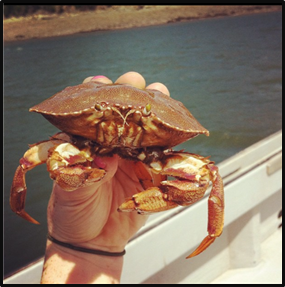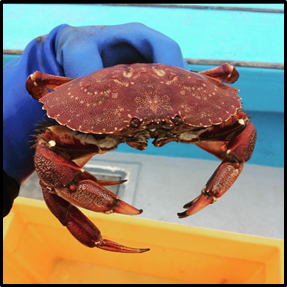Atlantic rock crab
Cancer irroratus
On this page
- Description
- Size
- Range
- Habitat
- Life history
- Diet
- Reproduction
- Interaction with humans
- Common names
- Science advice and research
- Related links
Description
The Atlantic rock crab, Cancer irroratus, is a decapod crustacean. As with all decapods, it has 10 appendages including the 2 claws that it uses to fight and to feed.
The carapace (the hard upper shell) is smooth, oval shaped and can range in colour from yellowish-brown to reddish-purple. Their shape and colour give them an uncanny resemblance to rocks or sand, making them camouflage well on the ocean floor to hide from predators. This crab has 9 points on either side of the carapace from the eye to the widest point.
Size
Male rock crabs are larger than females. Males reach maximum sizes between carapace widths of 140 and 150 mm and females reach a carapace width of around 100 mm. As with all animals with an exoskeleton, also known as the shell, the rock crab must cast off its shell to grow bigger and develop a new one - a process called moulting. Even when they are fully mature, they continue to moult and grow.
Range
Atlantic rock crab are present throughout the Northwest Atlantic from eastern Florida, United States to northern Newfoundland and Labrador, Canada.
Habitat
The rock crab is a benthic species, meaning they live on the ocean floor. They occupy a wide range of depths from above the low tide line, down to depths of up to 750 m. In more northern parts of their range they are more often in shallow coastal waters from 0 to 20 m deep. They are found on all types of surfaces, but have a preference for sand, gravel and rock.
Life history
Eggs hatch from late spring to early summer. Their life begins as larvae, a phase during which they swim freely in the water column near the surface, in a layer of the sea called the pelagic zone, feeding on smaller plankton particles. The larvae will develop through 5 stages, called zoea, before transitioning to the megalops phase, where the first claws and legs will appear and the young crab’s body will look more like that of an adult. During the larval phase, rock crabs are highly vulnerable, being preyed on by other zooplankton and planktonic fish.
Once on the bottom of the sea, also called the benthic zone, the rock crab starts its adult life. It will continue to grow through molts, a process by which it sheds its hard shell and develops a new one, even when it has reached maturity. They normally live up to 8 years.
Diet
Rock crab are generalist and feed by opportunistic scavenging and predation of smaller creatures. Their diet can consist of:
- small crustaceans
- mollusks
- gastropods
- worms
- plants
- fish such as sand lance, herring and cunner
Reproduction
Males reach sexual maturity around 70 to 75 mm carapace width, while female generally reach sexual maturity around 60 mm carapace width. Mating takes place in late summer and early autumn, after the females have moulted. During mating, the male embraces the female tight in his grip against his abdomen. Several days after mating, the female will extrude from 4,000 to 500,000 eggs depending on her size. The female will carry the eggs on her abdomen for about 10 months until they hatch.
Interaction with humans
In Canada, rock crabs are harvested for human consumption and for use as bait for other fisheries such as the lobster fishery. Rock crab are the targeted species during a directed fishery, but can also be retained when they are caught as a by-catch by lobster harvesters during their regular season.
By-catch refers to catches made during fishing that do not correspond to the species and sizes targeted by the directed fishery.
The directed fisheries for rock crab are in coastal waters of the Atlantic provinces and Quebec. The fisheries only allow the retention of male crabs. Females are released quickly to minimize the impact on the reproductive potential of the populations. The minimum legal size in most regions is 102 mm carapace width, with the exception of fishing areas 26A and 26B in the Northumberland Strait where the minimum size is 108 mm for the directed rock crab fishery.
Common names
Atlantic rock crab
Brachyuran crab
Shortened vernacular crab
Science advice and research
- Assessment of rock crab stock status in Quebec in 2016
- Update to 2017 of the fishery indicators for rock crab (Cancer irroratus) in the southern Gulf of St. Lawrence
- Rock crab, Cancer irroratus, fishery and stock status in the southern Gulf of St. Lawrence: LFA 23, 24, 25, 26A and 26B
For a full list of the department’s research on rock crab, visit our publications page.
Related links
- Rock Crab (Cancer irroratus), Emerging Species Profile Sheets, Newfoundland and Labrador Government, Department of Fisheries, Forestry and Agriculture (PDF, 178 KB)
- Cancer irroratus, Atlantic rock crab, Food Habits, University of Michigan, Museum zoology
Sources
DFO. 2002 Southern Gulf of St. Lawrence rock crab (Lobster fishing areas 23, 24, 25, 26A and 26B). Sci. Stock Status ReportC3-04(2002). Fs76-1-C3-04-2002-eng.pdf (PDF, 326 KB).
DFO. 2017. Update of the fishery indicators for rock crab (Cancer irroratus) in the southern Gulf of St. Lawrence. DFO Can. Sci. Advis. Sec. Sci. Resp. 2016/053. Fs70-7-2019-007-eng.pdf (PDF, 589 KB)
Haefner, P.A. 1976. Distribution, reproduction and moulting of the rock crab, Cancer irroratus Say, 1917, in the mid-Atlantic Bight. J. Nat. Hist. 10: 377-397. https://doi.org/10.1080/00222937600770291
Hanson, J.M., Comeau, M. and Rondeau, A. 2014. Atlantic rock crab, unlike American lobster, is important to ecosystem functioning in Northumberland Strait. Transactions of the American Fisheries Society 143:1266–1279. https://doi.org/10.1080/00028487.2014.931300
Reilly, P.N., and Saila, S.B. 1978. Biology and Ecology of the Rock Crab, Cancer Irroratus Say, 1817, in Southern New England Waters (Decapoda, Brachyura ). Crustaceana, 34, 121-140. https://www.jstor.org/stable/20103265
Rondeau, A., Hanson, J.M., and Comeau, M. 2014. Rock crab, Cancer irroratus, fishery and stock status in the southern Gulf of St. Lawrence: LFA 23, 24, 25, 26A and 26B. DFO Can. Sci. Advis. Sec. Res. Doc. 2014/032. vi + 52 p. Fs70-5-2014-032-eng.pdf (PDF, 4.68 MB)
- Date modified:



